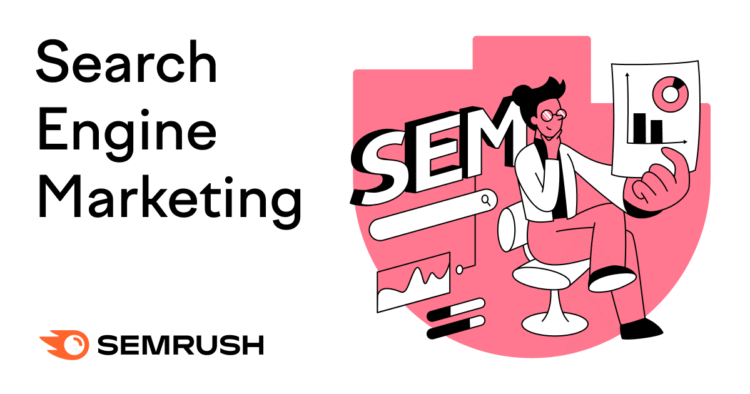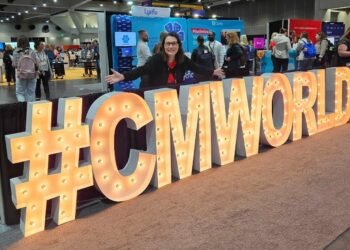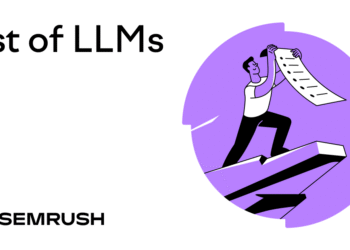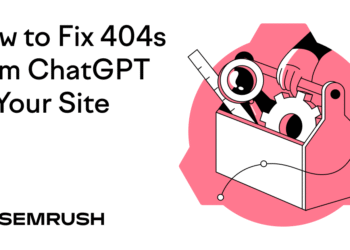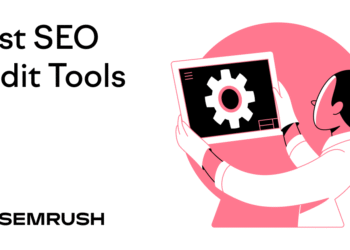What Is Search Engine Marketing?
Search engine marketing (SEM) typically refers to running paid ads that can appear when someone searches for terms related to your business on search engines like Google and Bing. And those ads can drive targeted traffic to your website.
SEM puts your business in front of people actively searching for your products or services. This makes it one of the most effective forms of digital advertising for reaching highly motivated prospects.
In short, here’s how search engine marketing works in practice:
- You bid on keywords relevant to your business
- You create ads that appear when people search for those terms
- You pay a fee—which is typically based on when someone clicks your ad
SEM vs. SEO
SEM and search engine optimization (SEO) both help you get found on search engines, but they work differently. Here’s a summary of the main differences:
|
Factor |
SEM |
SEO |
|
Speed of results |
Hours to days |
Months to years |
|
Traffic durability |
Stops when you stop paying |
Can continue long after you publish the content |
|
Control level |
Complete control over campaign timing, placement, and messaging |
Limited control over rankings and when your content will be visible |
|
Budget requirements |
Ongoing monthly spend required |
Upfront investment in content and optimization, some maintenance costs |
|
Ideal for |
Product launches, seasonal campaigns, and competitive industries |
Long-term brand-building and businesses with a considerable amount of content |
|
Skills required |
Campaign management, bid optimization, and ad copywriting |
Content creation, technical optimization, and link building (i.e., getting others to link to you) |
SEM and SEO both have their pros and cons, but you don’t have to just use one or the other. In fact, the best approach for many businesses is to use a mix of both.

Generally, SEO is best when you have a limited budget and your focus is on building authority around your brand. SEO can also drive long-term ROI and help you reach users at all stages of the customer journey.
On the other hand, SEM is best when you want immediate visibility and sales. Or for time-sensitive campaigns (like when you’re launching a new product).
It’s also ideal for targeting specific audiences at specific stages of the buying journey (like when they’re close to making a purchase). Or for testing marketing strategies or tactics to quickly give you insights and data (at least compared to SEO).
How Much Does Search Engine Marketing Cost?
SEM costs can vary dramatically based on your industry, competition, and strategy.
Most marketers choose to use the pay-per-click model, which means you only pay when someone actually clicks your ad. So, one of the main factors that will affect your costs is the cost per click (CPC) for your target keywords—how much a single click on an ad for a given query costs.
In some industries, this can be just a few dollars per click. Like this example for the highly specific keyword “best cheap dog food for labradors”:

Industries like finance, medicine, and law will see much higher CPCs. For example, the CPC for “sacramento motorcycle injury lawyer” is almost $140:

If you were running ads to this keyword, it would cost around $140 just to get a click—not a conversion.
And industries like wellness, technology, and home repair fall somewhere in the middle. For example, the CPC for “contractor for kitchen remodel” is about $12.

Other factors that affect your SEM costs include:
- Competition: High levels of competition, both at the industry and keyword level, will naturally drive up SEM costs
- Geographic targeting: Bidding on keywords in cities often costs more than in less densely populated areas
- Quality and relevance: Well-optimized campaigns often cost less per click than poorly managed ones
- Timing: Costs can fluctuate based on seasonality, holidays, and even time of day
How to Create Your First SEM Campaign
Follow these steps to build a campaign that’s aligned with your search engine marketing strategy:
Step 1: Set Up Your Advertising Account
Start with Google Ads for your first SEM campaign. Google handles around 90% of global search traffic, making it the most effective platform for reaching your target audience.
To set up your account, go to the Google Ads homepage and follow the setup workflow. You’ll need to provide basic business information, choose your country and time zone, and set up billing information.

You’ll also need to choose your campaign’s objective, campaign type, and bidding strategy. Your objective is up to you, but you’ll want to choose “Search” as your campaign type.

Here are some tips for setting your bidding strategy:
- Choose “Maximize Clicks” bidding strategy while learning your campaign performance, then transition to maximizing conversions, before then adding a target CPA once you have more data (optional)
- Set maximum CPC limits to prevent overspending on expensive keywords
- Start with broader geographic targeting and narrow it down based on performance data (if relevant)
Further reading: How to Run Google Ads: A 10-Step Guide
Step 2: Find Valuable Keywords to Target
For your ads to appear in search results and actually contribute to sales, you need to bid on target keywords that are likely to drive conversions.
It’s possible to run campaigns that are more intended for brand awareness or to generate traffic. But we’re going to focus on ads meant to convert users given that’s often a priority for those new to SEM.
Start your PPC keyword research by listing the exact products or services you sell and the problems you solve for customers. These form the foundation of your keyword list because they represent what people actually search for when they’re ready to buy from businesses like yours.
You want to focus on terms that represent someone who is close to making a purchase decision. These terms can fall under two categories:
- Product/service keywords: Terms that directly describe what you offer. If you’re a plumber, this includes “emergency plumber,” “drain cleaning,” and “water heater repair.” For an online store selling hiking boots, this includes “hiking boots,” “waterproof hiking shoes,” and “men’s trail boots.”
- Problem-solving keywords: Terms people use when they have a problem you can solve. The plumber might target “clogged drain,” “no hot water,” or “leaking pipe.” The hiking boot retailer might target “best boots for hiking” or “comfortable hiking footwear.”
Avoid purely informational keywords in your first campaigns. Someone searching “how to unclog a drain” wants information, not a plumber. But someone searching “emergency plumber near me” wants to hire someone immediately.
Tools to Find the Right Keywords
You can find keyword data for free with Google’s Keyword Planner within the Google Ads interface.

But you get fairly limited data and filtering options.
Get more control and potentially more suggestions with Semrush’s Keyword Magic Tool. Just enter a seed keyword (broad term) related to your business and click “Search.”
You’ll see a list of keywords like this:

You’ll want to narrow down this list.
First, change the “Intent” filter to only show “Commercial” and “Transactional” keywords (these basically represent terms people search when they’re nearing a purchase decision). Then click “Apply.”

Next, if you have a maximum CPC you’re willing to pay, enter that in the “To” box under the “CPC (USD)” filter drop-down, then click “Apply.”
If you’re not sure what to expect here, you can use industry benchmarks like this as a rough guide. Just know that even CPCs within industries can vary. As your campaign runs and you start gathering more data, you’ll get a better idea of the kind of CPC you should expect for different keywords.
If you don’t want to specify a CPC for now, you can also just click the “CPC (USD)” column to sort the keywords by cost per click.

Use the filtered list of keywords to find three to 10 relevant terms to use for your first ad groups. Targeting more keywords can give you more data to work with. But it also means you’ll probably end up with terms that don’t perform.
Finally, validate your keyword choices by searching for them yourself. Look at what ads currently appear and what types of businesses are advertising.

If you see relevant competitors running ads for these terms, it’s a good sign there’s commercial value in those keywords.
Step 3: Choose Your Campaign and Ad Group Structure
Create your campaign around a single business goal, product category, or service type to keep yourself organized and make it easier to learn from your results.
Keep your first campaign structure simple with one campaign and two to five ad groups at most to avoid creating too much work that might not pay off when you’re just starting out.
Ad groups are clusters of ads with similar targeting. They let you organize your ads around a common theme, like specific products or services you offer.
You’ll also want to match your ad groups to your website structure. So, create separate ad groups for each product category if you have separate pages for different categories. This makes it easier to send people to the most relevant landing page.

Here’s an example of how a local plumber could structure an ad campaign:
- Campaign: Emergency Plumbing Services
- Ad Group 1: Emergency Plumber (keywords: “emergency plumber,” “24 hour plumber,” “plumber near me”)
- Ad Group 2: Drain Cleaning (keywords: “drain cleaning,” “clogged drain,” “blocked drain”)
- Ad Group 3: Water Heater Repair (keywords: “water heater repair,” “no hot water,” “broken water heater”)
Once you’ve started running your campaign and gaining data, you can always decide to expand later.
Step 4: Create Conversion-Oriented Landing Pages
Your landing page—the page users land on when they click your ad—should be designed to convert visitors into leads or sales.
In most cases, you should send people to dedicated landing pages—not your homepage.
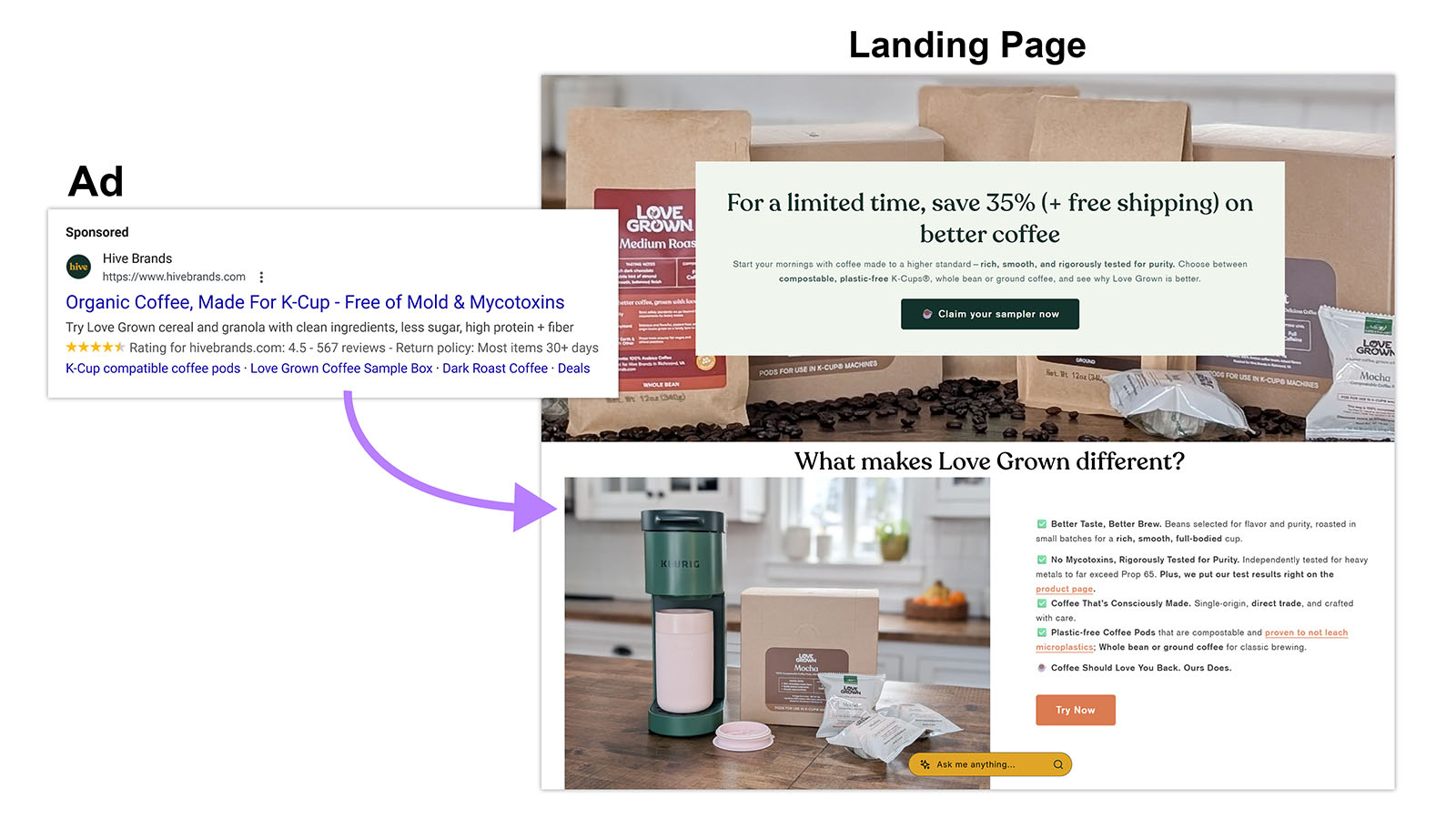
When someone clicks an ad for “emergency plumber,” they should land on a page specifically about emergency plumbing services, not a general plumbing website homepage. This relevance can improve conversion rates and your ROI from your SEM campaign.
To optimize your landing page, include the following elements:
- Clear headline that matches your ad copy
- Keywords visible on the page
- Prominent call to action with words like “Call Now” or “Get Free Quote”
- Trust signals like reviews, certifications, or guarantees
- Contact information displayed prominently and in a mobile-friendly way (e.g., tappable call/email buttons)
- Focused messaging on one service or product
- Benefit-focused copy that explains what the potential customer will get
Start with one well-optimized landing page per ad group rather than trying to create the perfect page for every keyword. You can improve and refine your pages based on actual performance data once your campaigns are running.
Step 5: Write Your Ads
Your ads should directly address what people are searching for, give searchers a clear reason to choose your business, and align with what your landing page says.
Every search ad has three main components:
- Headlines
- Descriptions
- Display URL
Of these three, your headline and description are most important.
Before you start writing, get some inspiration from your competitors.
How to Get Ad Copy Inspiration
Use Semrush’s Advertising Research tool to see which ads your competitors are running and how well they’ve performed over time.
This lets you see winning combinations of headlines and descriptions that you can use as inspiration for your own ad copy. This lets you focus on what works—wasting less time and ad budget.
Start by entering a competitor’s domain into the tool and clicking “Search.”
You’ll see an overview of their paid search trends and top positions. But we’re interested in the “Ads Copies” tab.

Here, you’ll see the exact copy they’re using for their ads.
And if you click the “Keywords” drop-down under an ad, you’ll see the search queries that trigger that ad in search results.

Use these ideas to help you come up with your own ad headlines and descriptions.
How to Write Strong Ad Headlines
Headlines are the most important because they’re what people usually notice first, which influences whether searchers will read the rest of your ad.

Start your headlines with a main keyword when possible to show searchers that your ad matches what they’re looking for. So, your headline might be “Emergency Plumber Available” or “Emergency Plumbing in [Location]” for the keyword “emergency plumber.”
Consider adding your unique selling proposition in your headline. What makes you different from competitors advertising for the same keywords?
Maybe you offer same-day service, have 20 years of experience, provide free estimates, or guarantee your work. (You can try these sorts of variations in the description if it’s hard to fit into the title.)
Just note that Google will try different headline combinations based on the ones you add to see which ones perform best. So you might see your ad with a slightly different headline to the ones you specify.
Finally, make sure your individual headlines are no longer than 30 characters.
How to Write Compelling Descriptions
Use your descriptions to provide additional details that support your headlines and compel searchers to click.

Include specifics like service areas, hours of operation, special offers, or credentials.
As with headlines, Google can test combinations of the descriptions you set. The character limit for descriptions is 90 characters.
Here are two example ads for a plumber’s drain cleaning ad group that have descriptions designed to build off the headlines:
Ad 1:
- Headline: Professional Drain Cleaning Service
- Description: Fast drain cleaning for clogged sinks, tubs & toilets. Call now for free estimate.
Ad 2:
- Headline: 24/7 Clogged Drain Repair
- Description: Professional drain cleaning. Advanced equipment clears any blockage. Call for free quote.
Step 6: Finalize Your Ad Setup
The next step is to set up your ad targeting, add your keywords, and finalize the copy for each ad. You’ll also set your budget here too.
First, set up basic settings like your target location and language. Also choose your target audience segments.

Next, add your keywords that you found in Step 2. You’ll add these at the ad group level (revisit Step 3 for more on creating ad groups).
Group your keywords by theme, or by the product or service they’re targeting.

(You can create new ad groups for the same campaign as you do more keyword research.)
You can then add your headlines and descriptions you created earlier.

Finally, choose your budget. Google will suggest some options for you here, but what you choose will depend on your business’s actual SEM budget and what you’re trying to achieve with your ads.

For your first SEM campaigns, start with a conservative daily budget that you’re comfortable spending while you learn what works. It should give you enough data to optimize without risking large losses if campaigns don’t perform immediately.
Step 7: Launch, Gather Data, & Optimize
Launch your campaign and resist the urge to make changes for at least a week or two. Google’s algorithms need time to optimize your campaigns, and you need sufficient data to make smart decisions.
The metrics you’ll want to keep an eye on as your campaign runs include:
- Impressions: Shows how often your ads are shown to users in search results
- Cost per click (CPC): Tells you how much you’re paying for traffic
- Conversions: Shows whether the people clicking your ads are actually buying from you (you’ll need to set up conversion tracking to see this)
- Click-through rate (CTR): Measures how often people click your ads when they see them
- Return on ad spend (ROAS): Shows you how much revenue you generate for every dollar you spend on advertising (you’ll need to track this yourself)
Which Optimizations to Make First
Once you’ve gathered enough data, here are the first optimizations to make:
- Add negative keywords: Avoid bidding on irrelevant search terms by marking them as negative keywords (i.e., terms you don’t want your ads to show for)
- Pause underperforming keywords: A keyword that gets clicks but no further results is just wasting your ad budget
- Improve low CTR ads: Rewrite headlines or descriptions for poorly performing ads and monitor the impact on CTR
- Give successful campaigns more budget: It’s better to maximize what’s already working than to spread your budget across too many campaigns
Most successful SEM campaigns require ongoing refinement based on real performance data.
How Do AI Overviews Affect Search Engine Marketing?
Google’s AI Overviews (AIOs) are unlikely to massively impact search engine marketing campaigns—at least for now.
AIOs and similar features from other search engines are reducing click-through rates for organic results.
But a Semrush study shows about 88% of queries that trigger AI Overviews are informational. These are typically queries where a user is seeking information—they’re not trying to purchase something.
In other words, these queries are not where you’d be focusing your SEM efforts. So the impact of AI Overviews in their current form is likely to be lower for SEM campaigns than for SEO.
Set Up Your Winning SEM Campaign Today
A successful search engine marketing campaign takes time, effort, and investment. Following the steps above will help you lay the foundations.
But you can streamline things even further with the Semrush Advertising Toolkit. It lets you do everything from competitive research to campaign planning.
Try it today.

